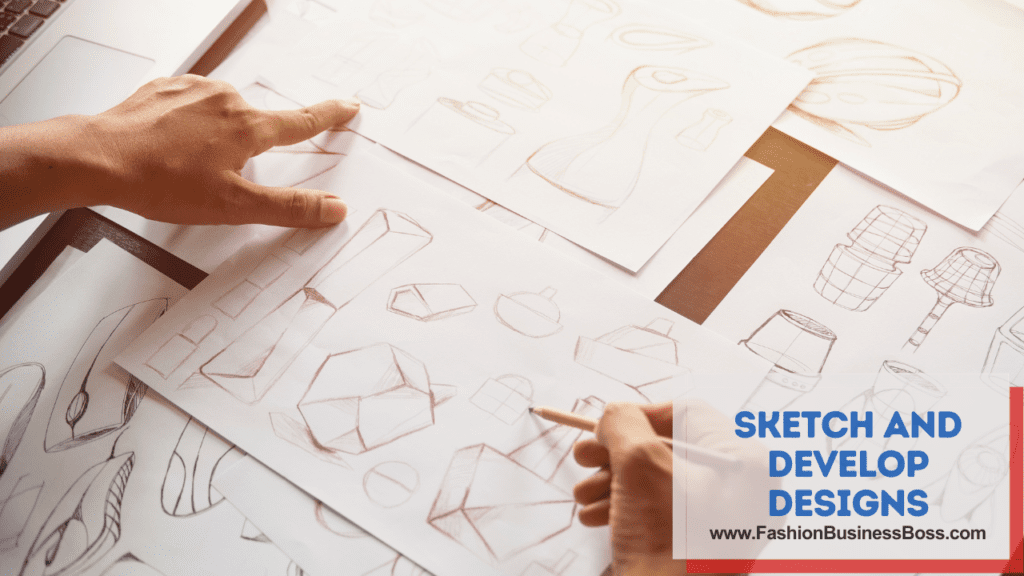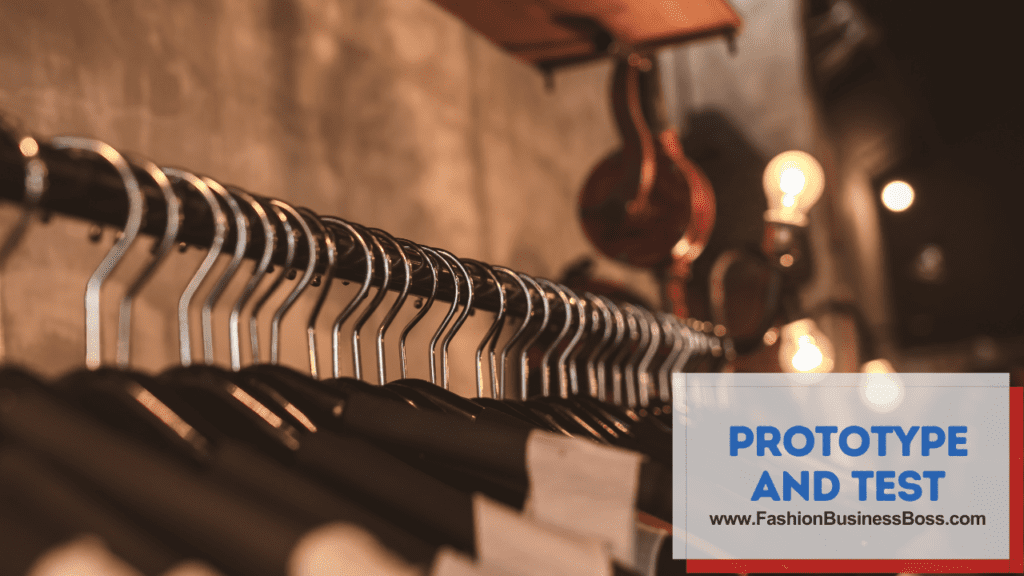The art of clothing manufacturing is not only a craft but also an entrepreneurial endeavor. It allows you to create unique, personalized garments or even launch your own fashion brand.
To manufacture your own clothes, begin with making your designs, source quality materials, locate a manufacturer, and hire skilled staff. It’s a journey of creativity and entrepreneurship.
In this article, we will take you through the step-by-step process of manufacturing your own clothes.
Sketch and Develop Designs

To begin the process of manufacturing your own clothing, you’ll need to start with the creative aspect—sketching and developing designs. This is where your fashion journey truly takes shape.
Start by grabbing a pen and paper and create preliminary sketches of your clothing ideas. These initial drawings don’t have to be works of art; they’re meant to be simple representations of your vision. These rough sketches are a great way to get your ideas down on paper so you can start to visualize your designs.
As you move forward, it’s time to take those rough sketches and refine them into detailed designs. This step involves adding specific elements to your drawings, like buttons, zippers, unique patterns, or any distinctive features you want your clothing to have. It’s essential to focus on proportions and details during this phase.
For those who are comfortable with digital tools, consider using software like Adobe Illustrator to transform your designs into a digital format. This approach offers more precision and allows you to experiment with different colors and patterns digitally. It’s a valuable method for fine-tuning your clothing concepts.
Read more about: Dive into the World of Fashion: Clothing Company Start-Up
Create Technical Drawings
In the next phase of the clothing manufacturing process, you’ll transition from creative sketches to creating technical drawings. Technical drawings are the detailed, accurate plans that serve as the blueprint for making your clothing ideas a reality.
Start by taking your initial design sketches and transforming them into technical drawings. These drawings are essential for guiding the manufacturing process. They contain precise measurements, specifications, and all the critical details needed to produce your clothing items accurately.
To create these technical drawings, you’ll need to pay close attention to every aspect of your design. Include measurements for lengths, widths, and any other dimensions that define your clothing piece. Specify the type of fabric to be used and note any specific features, like pockets, buttons, or zippers. These drawings should leave no room for ambiguity, providing manufacturers with clear instructions.
Fabric Selection
Selecting the appropriate fabric for your clothing designs is a fundamental step in the manufacturing process. It necessitates a comprehensive approach, starting with diligent research to identify and understand the various fabric options available. This research provides insights into the unique characteristics, advantages, and disadvantages of each fabric type. Such knowledge forms the basis for informed decisions when choosing the materials that will bring your designs to life.
During the fabric selection process, several crucial factors must be considered. First, texture plays a pivotal role as it directly impacts the tactile experience of your clothing. It’s essential to ensure that the chosen fabric’s texture aligns with your design goals and meets your desired comfort level. The color of the fabric is another essential consideration, as it significantly influences the visual appeal and message conveyed by your clothing. Weight is a practical concern, as different fabric weights determine the thickness and heaviness of your garments, making it important to select materials suitable for the intended season and purpose. Durability is key to ensuring that your clothing will withstand wear and tear, contributing to its longevity and overall quality.
Establish Supplier Relationships

Creating solid supplier relationships is a vital step in the clothing manufacturing process. It involves several key actions that are essential for a smooth and cost-effective production journey.
To begin, you need to identify fabric suppliers that are reliable and can provide the materials you need for your designs. Reliability is crucial, as it ensures a consistent and timely supply of fabrics, preventing delays in your manufacturing process. Research and gather information on potential suppliers, considering factors such as their reputation, product quality, and their ability to meet your specific fabric requirements.
Once you’ve identified prospective fabric suppliers, the next step is to negotiate pricing and secure favorable deals. This negotiation process is vital to help you obtain competitive pricing for the fabrics you need. It’s about finding a balance between quality and cost. Open communication with your suppliers is key here, as it allows both parties to reach mutually beneficial agreements.
Read more about: Dream, Design, Deliver: Starting Your Clothing Label
Source Accessories and Trims
Sourcing accessories and trims stands as a pivotal element within the clothing manufacturing journey. This task revolves around the discovery of dependable suppliers for fundamental items such as zippers, buttons, threads, and various other essential accessories, all of which play a crucial role in the completion of your garments.
Primarily, the quest for suitable suppliers holds significant importance. It is imperative to seek out suppliers with a specialization in providing these essential accessories, as their expertise can offer a diverse array of choices to cater to your specific needs. A seamless manufacturing process hinges on your ability to pinpoint suppliers capable of consistent and punctual deliveries, ensuring that your production stays on track.
Above all, the emphasis falls on the quality of these accessories and trims. Upholding your established quality standards is a non-negotiable priority. This involves a thorough evaluation of factors such as durability, aesthetics, and functionality for items like zippers and buttons. Overlooking quality can lead to inconsistencies or subpar components that may introduce defects into your final products, potentially incurring extra costs and production delays. In essence, prioritizing the quality of sourced accessories and trims is a cornerstone of maintaining the excellence of your clothing line.
Develop Patterns
Developing patterns is a critical step in the clothing manufacturing process, as it serves as the bridge between your technical drawings and the actual creation of garments. Here, we’ll outline how to go about this process clearly and simply.
Begin by translating your technical drawings into patterns. These patterns are like templates that guide the cutting and assembly of fabric pieces. They provide the precise dimensions and shapes required to turn your design ideas into tangible clothing items. Your technical drawings act as a reference during this pattern development phase.
To create patterns, you can use various tools such as paper, cardboard, or specialized software. Traditional methods involve working with paper or cardboard, where you manually draft and cut out pattern pieces. This requires attention to detail and accuracy, as any mistakes can impact the final product.
Alternatively, modern technology offers software that simplifies the pattern-making process. These digital tools allow you to input your design details and generate patterns with precision. They are especially helpful for complex designs and can save time and reduce errors.
Prototype and Test

Creating prototypes and conducting tests are integral phases in the clothing manufacturing process, helping to guarantee that your designs are not just on paper but genuinely meet your expectations in terms of fit and appearance. Let’s delve into this process in a straightforward manner.
Begin by producing prototypes of your designs. These prototypes are essentially trial versions of your clothing items. They serve as real-world representations of your vision, allowing you to assess how they fit and look when worn. The goal is to ensure that the actual garments match what you envisioned during the design phase. It’s an opportunity to detect any issues and make adjustments.
During the testing phase, pay close attention to the fit and appearance of the prototypes. Assess whether the clothing hangs correctly, if the seams align, and if the overall look is as intended. If any discrepancies or imperfections emerge, it’s essential to make the necessary adjustments to the patterns.
Read more about: Dress to Impress: Top Websites for Making Your Own Clothes
Locate a Sample Manufacturer
Securing a sample manufacturer is a pivotal step in the clothing manufacturing process. This phase enables you to bring your designs to life in a tangible form and evaluate their real-world potential. To facilitate this process, let’s break it down into clear and straightforward steps that anyone can understand.
Firstly, your quest involves locating a proficient sample maker or sample production company. These are individuals or businesses skilled in translating your patterns and designs into physical clothing samples. Consider factors such as their experience, reputation, and track record in producing high-quality samples.
Once you’ve identified a suitable sample manufacturer, the next step is to provide them with your patterns and the chosen fabric. Your patterns serve as the blueprint for creating the samples, guiding the sample maker on how to cut and sew the fabric to construct a garment that aligns with your vision. The fabric you supply is the material from which the samples will be made, ensuring that the final pieces accurately represent your intended look and feel.
Establish Your Workshop
The establishment of your clothing manufacturing workshop represents a pivotal phase in the production process. At this juncture, you must decide where and how you’ll transform your clothing designs into tangible items. This can involve the choice of in-house production within your own premises or the alternative of outsourcing to external manufacturers. We’ll now elucidate this process in a straightforward manner.
The initial decision revolves around the method of manufacturing, whether it will be in-house or through outsourcing. In-house manufacturing signifies taking on the responsibility of overseeing the entire production process within your own workspace. On the other hand, outsourcing entails collaborating with external manufacturing partners who will handle the production on your behalf. Your decision will hinge on various factors, including the resources at your disposal, the scale of production, and your expertise in the field.
Hire Skilled Labor

The process of hiring skilled labor is a fundamental aspect of clothing manufacturing. It involves bringing together a team of experienced individuals, including seamstresses, cutters, and quality control personnel, to ensure the smooth execution of your clothing production. Here, we will elucidate this process clearly and in a manner that is easy to comprehend.
Commence the hiring process by seeking out and recruiting individuals with relevant experience in the roles of seamstresses, cutters, and quality control personnel. These individuals should possess a proven track record in their respective fields, as their expertise is crucial to the quality and precision of your clothing items.
Upon assembling your team, it is important to provide them with comprehensive training and clear guidelines. This training equips them with the necessary skills and knowledge to consistently produce clothing items that meet your standards. Guidelines ensure that the work is carried out consistently and in alignment with your design specifications.
Read more about: Dress with Confidence: Mastering Your Unique Style
Manufacturing Process
The clothing manufacturing process is a structured and essential series of steps that transform your designs into tangible garments. It involves a methodical approach and quality control checks at different points to ensure the overall quality of the products.
First and foremost, it is imperative to establish a systematic production workflow. This is essentially a step-by-step plan that guides the creation of your clothing items. It ensures that each stage, from cutting fabric to sewing and finishing, is carried out in an organized and efficient manner. Following this structured workflow is essential for maintaining consistency and order throughout the production process.
Moreover, quality control plays a crucial role in the manufacturing process. Quality checks are implemented at various stages of production to assess the clothing’s integrity. This includes inspecting fabric, evaluating stitching and seam quality, and assessing the overall finish of each garment. These inspections help identify and rectify any issues or defects, ensuring that the final products meet your established standards for quality and appearance.
Labeling and Packaging
Labeling and packaging are crucial steps in the clothing manufacturing process, aimed at ensuring that your garments are well-documented and presented attractively. Here, we’ll explore these steps without unnecessary complexity.
The labeling process involves adhering to regulations that dictate the information to be displayed on clothing labels. This typically includes care instructions, size details, and information about the materials used. Compliance with these regulations is essential to provide consumers with accurate and useful information about your products.
On the packaging front, your goal is to create packaging that is not only visually appealing but also environmentally friendly. Attractive packaging can enhance the overall presentation of your clothing items, making them more appealing to potential customers. Choosing eco-friendly packaging materials demonstrates a commitment to sustainability, which is increasingly valued by consumers.
Pricing Strategy

Crafting a well-thought-out pricing strategy stands as a pivotal component within the clothing manufacturing process. This strategy involves a systematic approach to determine the pricing of your garments, ensuring that they remain competitive while aligning with your financial objectives.
To establish a robust pricing strategy, it is essential to account for several critical factors. First and foremost, you need to calculate the production costs linked to the creation of each clothing item. These expenses encompass various aspects, such as the cost of fabric, labor, equipment, and any other direct expenditures tied to the manufacturing process.
Furthermore, you must take into consideration overhead expenses, which constitute the indirect costs essential for running your clothing business. These expenses comprise items like rent, utilities, and administrative costs that collectively contribute to the overall operational expenses of your enterprise. This comprehensive approach to pricing strategy ensures that your clothing items are both competitively priced in the market and in alignment with your financial aspirations, thus fostering the sustainability and growth of your clothing venture.
Read more about: Dressing for Digital Growth: Selling Clothes Online
Conclusion
Manufacturing your own clothes is a journey that combines creativity, skill, and entrepreneurship. From the initial concept to designing, sourcing materials, and manufacturing, this has provided an overview of the process. While it’s a challenging endeavor, with dedication and hard work, you can turn your clothing manufacturing dream into a reality. Whether you’re creating a unique wardrobe or launching a fashion brand, remember that the key to growth lies in passion, innovation, and a commitment to quality.
Frequently Asked Questions

Q: What materials are commonly used in clothing manufacturing?
A: Common materials used in clothing manufacturing include cotton, silk, polyester, and various fabric blends, with the choice depending on style, comfort, and functionality.
Q: How can one find reliable clothing manufacturers?
A: To locate reliable clothing manufacturers, individuals can conduct research through online directories, attend trade shows, or seek referrals from industry contacts.
Q: What are some key factors to consider when pricing manufactured clothes?
A: Key factors to consider when pricing manufactured clothes include calculating production costs, overhead, and desired profit margins, along with conducting market research to set competitive and appealing price points.
To learn more about starting your own clothing business, check out my startup documents here.
Please note that the contents of this blog are for informational and entertainment purposes only and should not be construed as legal advice. Any action taken based on the information provided in this blog is solely at your own risk. Additionally, all images used in this blog are generated under the CC0 license of Creative Commons, which means they are free to use for any purpose without attribution.

Meet Shawn Chun: Entrepreneur and Fashion Business Fan.
I’m a happy individual who happens to be an entrepreneur. I have owned several types of businesses in my life from a coffee shop to an import and export business to an online review business plus a few more and now I create online resources for those interested in starting new ventures. It’s demanding work but I love it. I do it for those passionate about their business and their goals. That’s why when I meet a designer or boutique owner at a craft fair, farmers market, retail location or anywhere else I see myself. I know how hard the struggle is to retain clients, find good employees and keep the business growing all while trying to stay competitive.
That’s why I created Fashion Business Boss: I want to help fashion business owners like you build a thriving business that brings you endless joy and supports your ideal lifestyle.

